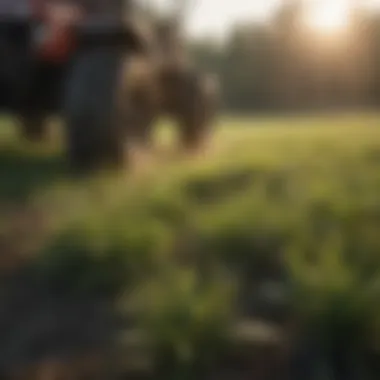Effective Strategies to Eliminate Crabgrass


Intro
Crabgrass is a pervasive weed that challenges gardeners and farmers alike. It spreads rapidly and outcompetes desirable plants for nutrients, water, and sunlight. Understanding its biology is essential for effective management. This article focuses on strategies to eliminate crabgrass through various methods that address both immediate removal and long-term prevention. The goal is to maintain healthy garden and agricultural landscapes that are free from this invasive species.
Current Trends in Agriculture and Horticulture
Overview of Recent Innovations
With the rapid development in agricultural practices, professionals have begun to implement innovative measures to control crabgrass. One such trend is the integration of smart technologys that assists with monitoring weed growth. For example, soil sensors can determine moisture levels, which in turn helps manage crabgrass by optimizing irrigation and avoiding excess water that favors its growth. Additionally, new herbicide formulations are becoming more targeted, reducing the impact on non-target species and the environment.
Sustainable Practices Gaining Popularity
Many farmers and gardeners are shifting towards sustainable practices that not only control crabgrass but also improve soil health. Crop rotation, for instance, disrupts the life cycle of crabgrass by varying planting schedules and types. Cover cropping is also gaining traction. This method enhances soil structure and nutrient content while suppressing weed growth, including crabgrass. Ultimately, these sustainable practices foster resilience against invasives like crabgrass.
Essential Farming Techniques
Soil Health Management
Healthy soil is the cornerstone of effective crabgrass control. Good soil management involves regular testing for pH and nutrient levels. Amending soil with organic matter, such as compost, improves structure and biodiversity. This creates an environment that favors desirable plants, making it harder for crabgrass to establish.
Pest and Disease Control Strategies
Implementing integrated pest management (IPM) is effective against crabgrass. IPM combines biological, cultural, and mechanical control methods. For example, thinning out crops reduces competition for light and resources. Additionally, careful mowing can prevent mature crabgrass from seeding, hindering its spread.
Tools and Technology in Farming
Overview of Advanced Farming Tools
Farmers now have access to advanced tools that assist in weed management. Drones equipped with imaging technology can identify areas heavily infested with crabgrass. By using precise treatment methods, herbicides can be applied where needed, minimizing overall chemical usage. This makes farming more efficient and eco-friendly.
Case Studies on the Use of Technology
A study conducted in California highlighted the use of soil moisture sensors in conjunction with digital mapping tools. These technologies allowed farmers to identify when to irrigate crops, leading to reduced crabgrass growth. As a result, crop yield increased while simultaneously lowering labor costs related to manual weed removal.
Maintaining effective crabgrass control requires continuous monitoring and adjustments based on observed growth patterns.
In summary, effectively eliminating crabgrass involves understanding its biology, employing innovative technologies, and incorporating sustainable farming practices. By combining these approaches, farmers and gardeners alike can achieve long-term success in weed management.
Understanding Crabgrass
Understanding crabgrass is crucial for effective management in both agricultural and gardening settings. This section illustrates the value of recognizing the biology and patterns of crabgrass to formulate better strategies for its elimination. A deep comprehension of crabgrass can empower farmers and gardening enthusiasts to minimize its impacts and ensure the vitality of their crops and landscapes.
Crabgrass, a perennial plant, often becomes a significant issue due to its resilience and adaptability. Knowing how it grows and thrives aids in creating proactive approaches for prevention and control.
Biology and Growth Patterns
Life Cycle of Crabgrass
The life cycle of crabgrass is a remarkable aspect that contributes to its notoriety as a pest. Crabgrass begins its life as seeds that can remain dormant in the soil for extended periods, sometimes even a few years. When conditions are favorable, these seeds germinate, typically in late spring to early summer.
A key characteristic of the life cycle is its rapid growth. Once established, crabgrass can produce thousands of seeds in a single season, which perpetuates the cycle. This prolific seed production is advantageous for crabgrass, as it ensures survival even when faced with management attempts. Recognizing this cycle allows gardeners and farmers to time interventions better and improve their success rates when aiming to reduce populations.
Environmental Preferences
Crabgrass thrives in warm, sunny environments. It prefers disturbed soils, common in agricultural settings or home gardens that have seen recent activity. The unique feature of its environmental preferences contributes to its success as a weed. This includes its capacity to tolerate drought and poor soil conditions, further advantages which make it challenging to eliminate.
Understanding these preferences enables landowners to modify their environments in ways that discourage crabgrass, such as improving soil quality or employing cover crops.
Why Crabgrass is Problematic


Competition with Crops
Crabgrass is known for its aggressive competition with crops. This invasive grass can outcompete desired plants for nutrients, water, and sunlight. Its sprawling habit allows it to overshadow shorter crops, stunting their growth and reducing yields. Understanding this competitive behavior is vital for farmers who seek to maximize their output.
Given its resilience and aggressive growth patterns, relying solely on crop management without addressing crabgrass can severely limit productivity.
Nutrient Depletion
Nutrient depletion is another important issue posed by crabgrass. As it grows, crabgrass consumes valuable nutrients from the soil, leading to a decline in soil fertility over time. This poses a significant challenge for farmers who aim for sustainable practices. The depletion of nutrients not only affects the immediate crops but can also have lasting impacts on soil health.
To manage this, it becomes necessary to employ strategies that replenish soil nutrients while controlling crabgrass, emphasizing the need for integrated approaches in agricultural practices.
"Understanding the life cycle and preferences of crabgrass is half the battle in effective management."
Addressing crabgrass not only enhances crop yield but also improves overall ecosystem health. The need for a multifaceted approach is apparent, creating an opportunity for ongoing research and adaptation in management strategies.
Preventive Measures
Preventive measures are the cornerstone of effective crabgrass management. Understanding and implementing proactive strategies can significantly reduce the chances of crabgrass infestation in both agricultural and gardening contexts. The emphasis on prevention not only saves time and resources in the long run but also fosters healthier crop growth and landscape aesthetics. By focusing on components like soil management and seeding techniques, one can create a resilient environment that discourages crabgrass germination and establishment.
Soil Management Practices
Proper Soil Aeration
Proper soil aeration involves creating air pockets in the soil, allowing for better gas exchange and root development. This process is essential because compacted soil is a conducive environment for crabgrass. By aerating the soil, one can improve the overall health of the plants and reduce competition from crabgrass. It is a beneficial method because it enhances nutrient uptake and encourages deeper root systems in desirable plants. However, one must be cautious; over-aerating can lead to soil disturbance, potentially exposing weed seeds.
Maintaining pH Levels
Maintaining the right pH levels in the soil is another critical aspect of preventing crabgrass. Soil that is overly acidic or alkaline can stress crops and create favorable conditions for weeds like crabgrass. The optimal pH range for most crops is around 6 to 7. This practice not only promotes healthy plant growth but also minimizes the chances of weed emergence. Yet, it requires regular testing and adjustments to keep the pH in check, which can be resource-intensive.
Seeding Techniques
Optimal Timing for Planting
Optimal timing for planting refers to scheduling sowing of desired crops in relation to the life cycle of crabgrass. Crabgrass is a summer annual, and by planting crops earlier in the spring, one can allow them to establish before crabgrass has a chance to germinate. This approach is crucial as it gives the crops a competitive edge against crabgrass. However, it is essential to be aware of local climate conditions to determine the best planting window.
Crop Rotation Strategies
Crop rotation strategies involve changing the types of crops grown in a particular area each season. This method disrupts the life cycle of crabgrass and other weeds, making it harder for them to establish. Crop rotation enhances soil health, reduces pest pressure, and promotes biodiversity. However, it may require additional planning and knowledge of compatible crops, which can be a learning curve for some farmers.
Effective prevention of crabgrass relies on understanding soil conditions, planting practices, and crop diversity.
Incorporating these preventive measures into farming and gardening practices fosters a proactive approach towards crabgrass management. This is not just about reducing the present weed population, but rather establishing a healthy foundation that resists future infestations.
Mechanical Control Methods
Mechanical control methods are crucial in the battle against crabgrass. These methods focus on physical removal and prevention instead of chemical solutions. They provide farmers and gardeners a proactive approach to managing weeds without relying solely on herbicides. Utilizing mechanical methods is both environmentally friendly and effective when executed properly.
Hand Pulling Techniques
When to Hand Pull
Hand pulling is most effective when crabgrass plants are young and less established. Targeting the weed early in its life cycle ensures a higher chance of completely removing it, including the roots. The best time to pull is after a rain, as moist soil allows for easier root extraction. Hand pulling requires diligence and persistence. It is beneficial because it does not involve chemicals that could harm other plant life.
Key Characteristic:
One notable aspect of hand pulling is that it allows for selective removal. This is vital for protecting desired plants in the garden or field.
Advantages and Disadvantages:
The advantage of hand pulling lies in its simplicity and the immediate effect it provides. However, it can be labor-intensive and may not be feasible for large areas. The effort might not scale well if a larger infestation exists.
Tool Recommendations


For hand pulling to be effective, having the right tools is important. Recommended tools include a hand trowel or weeding knife. These tools can help with digging up the root systems that may not be visible above ground.
Key Characteristic:
These tools allow for precision in removing crabgrass without disturbing neighboring plants.
Unique Feature:
The tools also help to prevent damage to the surrounding soil structure. With the right tool, the effort expended can lead to better results.
Advantages and Disadvantages:
Using tools for hand pulling ensures a more efficient process but still requires significant physical effort. Depending on the area to be cleared, using hand tools might take time but can yield a clean and chemical-free outcome.
Mowing Strategies
Timing of Mowing
Proper mowing techniques can be instrumental in reducing crabgrass growth. Regular mowing at the right height prevents crabgrass from reaching its reproductive stage. Mowing just before crabgrass flowers stops it from seeding, effectively limiting its spread. Adjusting the mower height to leave grass longer can also provide shade and competition, impeding crabgrass growth.
Key Characteristic:
Mowing must align with the growth schedule of both the grass and crabgrass to be effective.
Advantages and Disadvantages:
This method is beneficial for maintaining a healthy lawn while controlling crabgrass concurrently. However, excessive mowing can weaken desirable grasses if not managed well.
Impact on Growth
Regular mowing not only controls the size but directly influences the health of crabgrass. By consistently cutting back new growth, the weed can become stressed and less resilient. Over time, this leads to a decrease in crabgrass presence. Moreover, mowing can encourage the growth of thicker turf, which naturally competes with crabgrass for nutrients and sunlight.
Key Characteristic:
The strategy of mowing helps improve the overall health of the garden or field.
Unique Feature:
The impact of mowing on crabgrass can lead to a self-reinforcing cycle where healthy grass limits crabgrass from thriving. Well-timed mowing sets the stage for sustainable management of the lawn.
Advantages and Disadvantages:
While mowing is beneficial, it requires strategic planning to ensure it aligns with other growth patterns. Improper timing or failure to perform regular mowing can lead to crabgrass regaining strength quickly.
Chemical Control Options
Chemical control options play a significant role in managing crabgrass effectively. They offer targeted solutions when natural methods may not suffice. Understanding these options is crucial for anyone involved in agriculture or gardening to maintain the health of crops and landscapes. These methods not only help to eliminate existing crabgrass but also significantly reduce its competitive advantage against desirable plants.
Pre-emergent Herbicides
Application Timing
Application timing is essential for the success of pre-emergent herbicides. The effectiveness of these chemicals depends on their application before the weeds germinate. This characteristic makes them a popular choice among farmers and gardeners. Pre-emergent herbicides work by creating a barrier that prevents crabgrass seeds from sprouting. The unique feature of this method is its preventative nature, allowing growers to manage their weed problem before it arises. However, a notable disadvantage is that applying them too late will not yield any benefits as crabgrass may already be established.
Types of Herbicides
Different types of herbicides are available for pre-emergent control of crabgrass. These products may contain various active ingredients like Pendimethalin or Prodiamine. Their key characteristic is that they disrupt the germination of crabgrass while not affecting established plants significantly. This makes them effective for protecting crops. However, the unique aspect of each herbicide's chemical makeup may lead to specific application rules or environmental considerations. Some may require a longer waiting period before planting subsequent crops and can have residual effects in the soil.
Post-emergent Herbicides
Active Ingredients to Consider
Active ingredients in post-emergent herbicides are focused on targeting the visible crabgrass. Common examples include Quinclorac and Fenoxaprop. They have the essential quality of being effective against actively growing crabgrass, which can contribute significantly to the overall weed management strategy. The unique feature of post-emergent options is that they allow for immediate action against invasive plants. However, these herbicides often work best during specific growth stages of crabgrass, which may limit their utility later in the season.
Safety Precautions
Safety precautions are vital when using chemical control options. Understanding how to handle these products properly ensures efficacy while minimizing risks. Protective gear, such as gloves and masks, is a fundamental characteristic of using herbicides safely. They help avoid potential health hazards associated with exposure. This unique focus on safety can also protect beneficial insects and nearby plants. However, failure to adhere to safety procedures can lead to unintended consequences, such as environmental contamination or health risks for the applicator.
Ensuring the correct application timing and adherence to safety practices not only maximizes the effectiveness of chemical control options but also preserves the integrity of the agricultural ecosystem.
Organic Alternatives
Organic alternatives are essential for managing and eliminating crabgrass effectively in both agricultural and gardening contexts. These methods offer an eco-friendly choice for those looking to maintain a healthy environment, while still focusing on practical solutions. The use of organic alternatives not only addresses the issue of crabgrass but also contributes to soil health and overall plant vitality.


Natural solutions and techniques often have fewer side effects on beneficial insects and the surrounding ecosystem. Moreover, they can help sustain nutrient balances in the soil, which is a significant concern when using chemical treatments. By adopting organic strategies, farmers and gardeners can achieve a more sustainable approach to weed management.
Natural Herbicide Solutions
Vinegar Use
Vinegar, particularly white vinegar with a high acetic acid concentration, is known for its herbicidal properties. Its contribution lies in its ability to desiccate plants, effectively killing crabgrass upon contact. One key characteristic of vinegar is its fast action, making it a popular choice among organic gardeners. Unlike harsher chemicals, vinegar is readily available and can be applied directly to the surface of the plant.
This solution is beneficial because it minimizes the ecological impact compared to synthetic herbicides. However, it's essential to apply it carefully. Vinegar can harm desirable plants if sprayed indiscriminately. Therefore, timing and application technique are critical to maximizing its benefits while minimizing potential drawbacks.
Corn Gluten Meal
Corn gluten meal serves dual functions: it acts as an organic pre-emergent herbicide while also providing nutrients to the soil. This method best suits gardeners focused on prevention rather than eradication. The key characteristic of corn gluten meal is its ability to hinder seed germination, thereby reducing future crabgrass populations and ensuring healthier crops.
This organic alternative is advantageous because it is safe for plants and beneficial microorganisms in the soil. However, it requires specific conditions for effectiveness; optimal application timing is before crabgrass seeds germinate. Users may find it an additional expense but its long-term benefits on soil health make it worthwhile.
Mulching Techniques
Types of Mulch
Mulching serves multiple purposes in garden management, particularly in the realm of crabgrass control. The primary types of mulch include organic materials like straw, wood chips, and grass clippings. Utilizing high-quality mulch provides a barrier that prevents sunlight from reaching crabgrass seeds, effectively suppressing their growth.
The benefit of using mulch extends beyond weed control. It improves moisture retention, moderates soil temperature, and enriches the soil as it breaks down. Thus, mulching is a popular choice for those aiming for a holistic approach in their garden management. However, the type of mulch selected can impact its effectiveness and longevity, meriting careful selection based on local conditions.
Application Methods
Proper application of mulch is critical to its effectiveness. A recommended strategy involves spreading a layer of mulch about 2-4 inches thick across the sterilized bed. This technique not only prevents crabgrass but also supports a healthy garden ecosystem. The key characteristic of application methods is to ensure even distribution without smothering existing plants.
While applying mulch can require labor and resources, the payoff is substantial. Benefits, including weed suppression, soil moisture conservation, and enhanced fertility, outweigh the initial effort. Nonetheless, periodic maintenance, such as replenishing mulch layers, can be necessary to sustain these advantages.
Monitoring and Follow-Up
Monitoring and follow-up are crucial processes in the effective elimination of crabgrass. These steps help ensure that the strategies employed are yielding positive results and that any issues are promptly addressed. A key benefit of monitoring is the ability to assess the effectiveness of various control measures over time. Continuous evaluation provides valuable insights into the remaining crabgrass populations, environmental conditions, and the resilience of crops. Keeping records of findings allows for better planning of future interventions.
Additionally, following up on management practices enables farmers and gardeners to make necessary adjustments. The loss of efficacy in specific strategies can arise from changes in environmental conditions or crabgrass behavior. By staying vigilant and adapting, one can maintain healthier landscapes and crops, free from the threats posed by this invasive weed.
Evaluating Effectiveness
Identifying Reinfestation
Identifying reinfestation involves recognizing the resurgence of crabgrass in areas previously treated. This aspect is vital because successful crabgrass management depends on understanding its life cycle and habits. Observation for new growth can often prevent further spreading. One of the key characteristics of identifying reinfestation is the timing. Knowing when to look for early signs helps in managing the plant's spread. This practice is beneficial because it allows for prompt action.
Notably, the unique feature of this process is its focus on thresholds. Understanding how much crabgrass is present and assessing its growth rate can equip farmers with vital knowledge to take action before it becomes a substantial threat. Advantages include saving resources and reducing long-term chemical use, though challenges remain in recognizing visible signs consistently, as crabgrass can sometimes blend with other grass types.
Adapting Strategies Accordingly
Adapting strategies accordingly means changing your management tactics based on observed challenges. Flexibility in methods enhances the overall effectiveness of crabgrass control. A key characteristic of this approach is responsiveness. Farmers benefit by tailoring their measures to the specific conditions they face. This makes it a popular choice in effective management as it fosters continuous improvement.
The unique aspect of adapting strategies is that it involves integrating data collected during monitoring phases. This leads to well-informed decisions. The advantages here include optimized resource use and potentially lower costs. Disadvantages can arise if the adaptation is made without thorough analysis, leading to ineffective treatments that might have adverse effects on crops.
Ongoing Management Plans
Establishing Maintenance Schedules
Establishing maintenance schedules is about creating a periodic plan to manage crabgrass. Regular intervention helps to keep populations low and prevents resurgence. A notable feature of this tactic is its systematic nature. This practice is beneficial as it instills discipline in management efforts. By adhering to a schedule, farmers ensure that the necessary actions are executed at the right moments in the growth cycle.
One unique aspect of maintenance schedules is their adaptability to local conditions. Weather patterns and soil health can dictate necessary changes, and farmers can take these into account. Advantages include a proactive level of control and reduced dependence on reactive measures. However, if not followed with diligence, these schedules can fall short, placing emphasis on strict adherence to timings without revising based on results.
Integrating with Other Agricultural Practices
Integrating with other agricultural practices enhances the control of crabgrass while promoting overall crop health. This approach takes into account the interactions between various farming techniques. A key characteristic here is synergy. Using complementary practices like crop rotation or cover cropping further supports crabgrass management. This is a beneficial strategy as it fosters a holistic view of the farming system.
The unique feature of this integration is its collaborative nature between different practices. For instance, alley cropping can assist in nutrient retention, potentially reducing crabgrass growth. The advantages include improved resilience of the ecosystem and less reliance on chemical methods. One disadvantage might be the initial complexity of managing multiple techniques. Misalignment of practices or timing can inadvertently lead to reinfestation or other problems.



